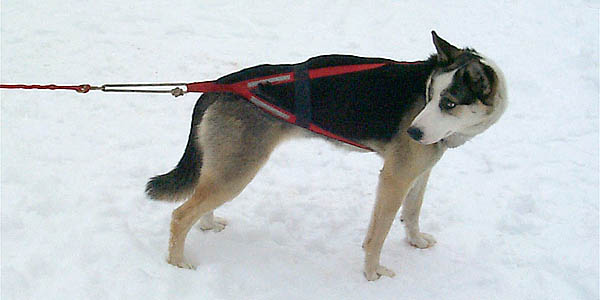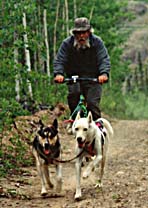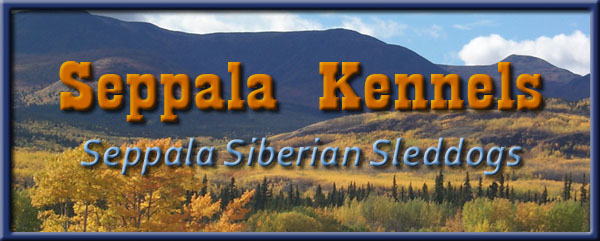Forming Green-broke Dogs into a Team
ONCE YOUR PUPS are broken to harness,
forming a team is simply a gradual process of learning by doing.
Consistency and patience should be your keynotes. Don't confuse
young dogs by inconsistent routines or behaviour. Hookups should
be methodical and as orderly as you can make them given the wild
enthusiasm with which young Seppalas usually greet each training
session. (Don't discourage them by demanding silence and stillness;
you won't persuade them! Over time they will gradually settle down
provided you get them out often enough.) It helps to have a
well-appointed hookup area for training runs, with a picket line of
aircraft cable or heavy vinyl-coated steel cable clothesline tightly
stretched between two trees or posts, with eighteen-inch drop chains
securely attached with bulldog clips (U-bolts specially made to grip
steel cable) to the main cable. The drop chains, with brass piston
snaps at the far end, keep the team in good order while you put
their harnesses on them, trim their toenails if necessary, and lay
out the lines. Chances are they will learn on their own to relieve
themselves while on the picket line before the run starts.
The main gangline should be directly attached
to a strong point (a post in the ground or an eyebolt on a vehicle
bumper or a building) by means of a snub line with a quick-release
'panic snap' of the kind used by horse trainers. Don't tie the sled
itself to the strong point; this practice results in too much wear
and tear on the sled. Use a good quality mountaineer's carabiner
with a locking sleeve to join the back loop of the gangline, the
snubline, the line from your snow hook, and your shock absorber;
this makes for a simple and secure union point where several
highly-stressed lines must be joined together.
Always make sure your dogs' toenails are
not too long before they train; long nails will break and can cause
foot injuries. Try to make sure that your dogs have had water
forty-five minutes to an hour before their run, to be sure they
are well-hydrated when they train, and offer them water again
when they return from the run.
TRAINING RUNS should be regular and
graduated in length and difficulty. In the fall you should start
with runs under a mile in length, particularly with young dogs.
We try to be sensitive about the physical limitations of puppies
and yearlings. A one-year-old sleddog does not have much by
way of endurance and physical reserves, so we never ask
a dog to go further than ten miles on a single run during his
first year of training. Building condition takes time and consistent
conditioning runs; sleddogs do not reach full physical maturity
until around three years of age. (Dogs under that age should
never be expected to participate in long-distance races, no
matter how well they have been conditioned.) It is simple to
build condition in a sleddog over a period of years, but once
a dog has been pushed into a physical or mental breakdown
by too much, too soon, he may never be the same again. It's
easy to wreck a sleddog just by pushing him too hard while he's
young.
Training dogs all weekend and then
leaving them in the kennel through the week is unfair and
harmful to them physically. In order to build condition, sleddogs
must be worked regularly. How you go about this can vary
according to your objectives and your schedule. Every other
day or two days on and one day off would be reasonable
schedules to begin with; later as your sensitivity to your dogs
develops you can judge by their performance, their condition,
and their mental attitude how frequently they need to be hooked
for a run. Never take a dog out more than once on the same day;
novice mushers often take unconditioned dogs out on holiday
weekends and run them ragged giving repetitive dogsled rides
to children or friends. Dogs resent being made to travel the
same trail twice over on the same day! In fact, you'll observe
that they eventually get bored with their regular training trail if
they must always run the same route. It helps to vary things up.
If they start misbehaving during runs or seem to lose their
enthusiasm, give them an extra rest day or two and then take
them to a less-familiar trail or, if that is not possible, cut back
on the distance, run the old trail backwards -- anything for a
change! Mature, experienced sleddogs in good hard condition
can convince you that they want to go out every day; but
eventually they will start to sour if you give in to those apparent
wishes. That said, Seppalas do seem to thrive on mileage, and
it is not unusual to put eight hundred to twelve hundred training
miles on a Seppala team over the course of a good winter, even
if you aren't involved in long-distance events. Usually a change
is more important to them than a rest.
However, it's not
smart to take dogs out in very challenging conditions if it isn't
necessary. When the mercury drops below minus thirty Celsius,
snow turns highly abrasive. Two or three days of running in hard
cold may result in cracks, cuts, and abscesses on foot pads,
thereby forcing a layoff while the dogs' feet heal. It's easier to
preserve feet than to heal them! Likewise taking a team through
overflow a lot (water on top of frozen lakes or rivers) is stressful
to them and shouldn't be a regular practice. Unfortunately in places
like the Yukon and Alaska, hard cold and overflow often occur
together. Feet can be protected by booties, but wet dog booties
must be removed immediately, so booties aren't much of an
answer to the problems of training in hard weather. Unless you
are in training for the Yukon Quest (a race whose challenges
amount to an inhumane situation for sleddogs, in my opinion), it
makes good sense to lay off when the bottom drops out of the
thermometer. Otherwise, when more temperate weather returns,
you may find yourself nursing a bunch of dogs with cracked feet,
frozen flanks and penises, and other woes of hard-weather running
and be unable to enjoy the nicer weather!
BUILDING A DOG TEAM is largely a matter of persistent work over time and common sense. It helps to think like a dog. Harsh discipline is almost always counter-productive with Seppalas, their sensitive nature responds much better to positive reinforcement. Your objective must be to prevent your dogs from making serious mistakes or from failing miserably in the formative period of their careers as sleddogs. If you make sure that their learning experience occurs in easy, graded steps and continued practice, then they build new skills on past success and never become discouraged. Gradually, all by themselves, they start to coordinate their pace and their timing with one another; all of a sudden, one day you realise that what started out as six or eight individual animals each with a mind of his own has now become a team, a group of dogs that run and manoeuvre almost with a single mind. It's a beautiful sight to behold, and gives a driver a sense of real accomplishment.
Lead Dog Training -- Out Front

NO TEAM CAN FUNCTION without
at least one lead dog and better two, unless the driver is willing
to emulate wilderness trappers and slog ahead of his dogs
through unbroken trails on snowshoes! (Don't try it!) This is
one of the really hard parts of the new dog driver's novitiate.
Until you have a dog that will hold the gangline stretched taut
while you hook the rest of the team, start on command, stop
on command, turn left and right on command, and pass by
other teams, obstacles and distractions, you may have a gang
of dogs but you don't have a team.
Training a lead dog is somewhat like
making big money. It's an uphill struggle to train a lead dog if
you don't already have a lead dog, just as it's hard to make
millions without seed capital. And, also like getting rich, there
are many different schemes that purport to guarantee you can
make your first sleddog into a leader. Some of them even work --
sometimes! The best advice I can give you is to adopt one of
two courses: either make a leader out of your first broodbitch
(if she isn't a leader to start with), or else find someone who's
looking for a home for a cast-off racing leader (the top
competitors probably won't have anything you could afford, but
all those also-rans trying to fight their way into first place tend
to shed a lot of hapless sleddogs along the way). Recognise that
such a dog may be "burnt-out" and have serious psychological
problems, and that there may be an extended adjustment
period before the dog will lead for you. It takes patience and
understanding to take over somebody else's old leader and get
him working for you; this just isn't a 'plug and play' situation.
Dogs learn best from other dogs.
Relatively few dog drivers turn out to be superior dog
trainers, really. Unless you have already proven yourself by
training scores of gun dogs or guard dogs, chances are you won't
be a great trainer, either. Therefore, your own homebred dogs
have the best chance of becoming leaders if they can learn their
skills from a dog who already knows what to do. Such a dog will
probably wind up teaching you, too. A bright young dog who is
willing to run without another dog in front of him can be hooked
at double lead alongside a canny, experienced leader, and in two
seasons he may become almost as good as the old dog, without
your doing anything except trying hard to avoid making mistakes
and messing up the process!
IF YOU CAN'T ACQUIRE a leader to start with, or if the dog you
acquire simply won't work properly for you (believe me, it
happens), then you must either take the mother of your puppies
(if you bought her outright) or the most promising youngster and
make yourself a leader by the sustained application of patience
and hard work. It's not easy, neither is it impossible.
Leader training is best done in
summertime on a mountain bicycle, using just the one dog you
want to train. (Letting one lead dog train another can also be done
on a bicycle, but two dogs should be the limit for bike training.)
Find a system of hiking trails or forestry roads (you really can't
do this on pavement in the suburbs) and get to work. Even if
your candidate is at first so confused that he or she won't lead
out ahead of the bike, you can start by letting the dog run
alongside the bike, with a ten or twelve foot tugline attached to
the front post of the bike between the fork and the handlebars.
Eventually you'll get the dog to stay "out front" and to start and
stop on command. After that, it's just a question of practice.
Don't be discouraged if your dog doesn't
run at top speed in this situation. We have seen some very good
leaders that were quite hesitant and slow on solo bike runs, only
to turn into fireballs when hooked in front of a team with another
dog beside them. Patience (again) is your keynote. Recognise
that this kind of training is as stressful to the dog as learning
differential calculus might be for you. Once a day is
enough, for no more than twenty minutes! But every
day, with a day or so off if your trainee shows signs of
discouragement or souring (by, for example, "blowing"
commands she already knows), during the summer is fine.
Keep your training to the coolest possible part of the day; go
out at the break of dawn if necessary. By fall, you should have
a dog that can at least stay ahead of the others, keeping the
line tight and keeping the rest all going in the same direction.
(You may not manage reliable "gee" and "haw" directional
control your first season.) Either you'll succeed to that extent,
or you'll know for certain that you must buy a leader from
someone. Be of good cheer -- it often turns out that that first
leader, trained by hard work, will be one of your best ever.

THE BASIC COMMAND set that a
leader should know is as follows: "out front" (go out to the end
of the gangline and hold it taut), "wahead" (starting command --
use whatever suits you but be consistent), "on by" (keep going
straight ahead, don't stop, don't investigate that distraction),
"gee" (turn to the right), "haw" (turn to the left), "dig, dig" (pull
hard), "easy, easy" (slow down), "let's go" (speed up), "whoa"
(stop), "no" (don't turn there, don't do that), "stay" (just keep
standing there, don't turn or bounce around). You may have a
special passing command that you use when overtaking other
teams, or you may just use "on by"; you may teach a leader to
"come gee" or "come haw" (one-hundred-eighty-degree turn),
although it's not essential and may be a liability, because leaders
like to do it and will often do it when not commanded, at the
worst possible moment! You may eventually manage to teach a
leader "gee over" and "haw over" (move to the left or the right
side of a wide trail), or "gee a little" and "haw a little" for fine
directional control on frozen lakes or where there are confusing
multiple snowmobile tracks, etc.
v That's the basic lead dog curriculum in
a nutshell. You won't teach it all to your trainee in a single season,
unless your dog is a canine genius. Be satisfied, at first, when you
have reached the point when you can hook up four to six dogs in
an orderly way, go out, run a trail with various turn options in
more or less the way you intended, and get home again without
big tangles or major hassles. At that point, the hardest part of
your dog-driving career is behind you, and you can legitimately
call yourself a musher. It may take you six weeks, or six months,
or a couple of years. That doesn't matter, because once you have
achieved that level of co-ordination between your dogs and
yourself, you will have begun to experience the real magic of
driving a dog team.
Bicycle Training

LET ME SAY a few more words about bicycle training! ATVs have become very popular for summer and fall training of sleddogs. They have the virtue that it's usually possible to hook a relatively large team and still keep control. They aren't the only way to train on wheels, though, nor even the best way necessarily. At the moment, Seppala Kennels doesn't even own an ATV! We prefer our bicycles and European-style handlebar tricycles (built from dirt-bike parts). Although it may take longer to get through all your dogs if you have to take them out two to four at a time, instead of twelve at once, ultimately you'll find you have a lot fewer problems and your dogs work more reliably if they are trained by twos and fours.
Here are some of the drawbacks of
training with an ATV. Dogs either detest the ATV motor's sound,
or else they learn to shirk their pulling task and let the motor do
the work for them, using the motor sounds as a cueing system!
Also in big teams it is much easier for individual dogs to get
away with shirking and letting others do the work. There is more
noise, more confusion, and the driver's attention is spread too
thinly. It is also easy to get going too fast. High speeds should
be avoided in wheel training. In early-season work the objective
is to build muscle and general condition, not to go fast. Excessive
speed on hard ground with under-conditioned dogs just invites
injuries.
We tend to feel that the bicycle is quite
under-utilised as a sleddog training tool! Dogs that are routinely
expected to go out without others ahead of them will run with more
confidence, and you may discover leader candidates that you didn't
know you had. Some words of caution: don't try training dogs on a
tall racing bike with skinny tires. Fat tires are essential, the bike
must not be too high, it must be strongly built, and the women's
style frame is a good idea. You may have to get on or off very fast
occasionally! If the pulling point is too high, it becomes easy to
upset the bike so smaller-diameter wheels are an advantage. Always
respect the two-dog limit -- if something goes seriously wrong when
you are trying to run more than that, you are going to get hurt and
the bike may well be a write-off, too.
